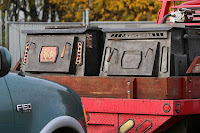This
is a response by Sylvia Shultz of the non-profit Clean Air Fairbanks to our
Blog Post on Best Practices in Change out Programs.
Sylvia takes issue with our assertion that Fairbanks employs a strategy
that we consider a "best practice." Her thought provoking response
is reproduced below. If others have substantive responses, please send them and we will consider reprinting them.
"Thanks
for sharing your blog post and asking for feedback.
In
your blog, you wrote that "Fairbanks may be the best example of effective
prioritizing based on location instead of using a first-come, first-serve
model."
The
only "best example" of practices for the Fairbanks PM2.5
non-attainment area is the City of Fairbanks ban on hydronic heaters. Other
than that, "best" at wasting public money is all the change-out
program can claim. $7.8 million has been spent on change-outs, with $1 million
more in the 2015 Capital Budget (expected to be signed by the Governor). It is
a unique among change-out programs in a PM2.5 non-attainment area as there is
little to prevent rolling back to the most polluting heaters and boilers.
The
Fairbanks North Star Borough (FNSB) and the State of Alaska continue to allow
any solid fuel or other heating device to be installed in this serious PM2.5
non-attainment area. However, in 2009, the City of Fairbanks banned new
hydronic heaters. Outside the city limits, without controls, PM2.5 levels are
far higher. But other than that single provision in city code, installation of
coal, wood, pellet, biomass, or waste oil burners for residential and
commercial use is unrestricted. New devices of every flavor, from $50
barrel stove kits to $20,000+ coal hydronic heaters, continue to be installed.
FNSB paid residents to install wood boilers, the State paid for $20,000
coal boilers (it won't say how many), and schools were converted to
wood (although that didn't work, and now are converting to natural gas with
state funding). State funding also paid for unreliable and ineffective
ClearStak catalyst retrofits on wood and coal boilers.
So,
while it is correct that FNSB uses location-based prioritization for the
voluntary change-out program to target air pollution hot zones, any type of
heater or boiler may be installed in these areas, as long as it is outside
the City of Fairbanks. Highly polluting heaters can be installed by owners
who been paid $11,000 to replace a hydronic heater. It is nonsense to herald
Fairbanks' prioritization method as a "best practices" model when
there is no restriction on new installations, even in hot zones. PM2.5 measured
in the cleanest area, the City of Fairbanks, rank among the worst in the
nation. Monitors from neighborhoods outside the city limits rank among the
worst in the world.
A survey in 2010 for the State
estimated a total of 3,360 uncertified woodstoves, coal heaters, and
outdoor wood boilers in the PM2.5 nonattainment area. After $7.8 million has
been spent, that is over $2,300 per uncertified heater. Spending another $1
million would bring the total per uncertified heater to over $2,600.
Yet, many uncertified heaters remain and more continue to be installed.
Ineffectively throwing money at a serious problem should not be held up as a
best practice. Most communities could not afford to undertake such an expensive
approach that demonstrates such poor results.
Please
review the Case Study on two Central Boiler 2300, Phase 2 qualified, in
Fairbanks AK. It was submitted to EPA as part of our NSPS comments. EPA seems
unaware of the problems and the judge's order in Alaska v.
Straughn that declared the operation of the boilers to be a "public
nuisance." EPA's proposed Step 1 emission standard would allow hydronic
heaters that have even higher emission levels than those in Alaska v.
Straughn.
The
FNSB change-out program paid Straughn $10,000 to remove one boiler, and agreed
to pay $10,000 for the second. This was after the judge ordered the owner to
cease operation of the boilers and later a settlement restricted the properties
to oil or gas heating. Paying to remove and destroy devices that can't even be
used at those properties serves only to prevent them from being sold and
installed elsewhere in the PM2.5 nonattainment area, even next door.
Thanks
for your reporting and attention to detail.
Sylvia
Schultz









